First Aid for Soldiers FM 21-11
FM 21-11 First Aid for Soldiers: Chapter 2
Basic Measures for First Aid
Headquarters, Department of the Army, Washington, D.C., October 27, 1988
INTRODUCTION
Several conditions which require immediate attention are: an inadequate airway, lack of
breathing or lack of heartbeat, and excessive loss of blood. A casualty without a clear
airway or who is not breathing may die from lack of oxygen. Excessive loss of blood may
lead to shock, and shock can lead to death; therefore, you must act immediately to control
the loss of blood. All wounds are considered to be contaminated, since infection-producing
organisms (germs) are always present on the skin, on clothing, and in the air. Any missile
or instrument causing the wound pushes or carries the germs into the wound. Infection
results as these organisms multiply. That a wound is contaminated does not lessen the
importance of protecting it from further contamination. You must dress and bandage a wound
as soon as possible to prevent further contamination. It is also important that you attend
to any airway, breathing, or bleeding problem IMMEDIATELY because these
problems may become life-threatening.
Section I. OPEN THE AIRWAY AND RESTORE BREATHING
*2-1. Breathing Process
All living things must have oxygen to live. Through the breathing process, the lungs
draw oxygen from the air and put it into the blood. The heart then pumps the blood through
the body to be used by the living cells which require a constant supply of oxygen. Some
cells are more dependent on a constant supply of oxygen than others. Cells of the brain
may die within 4 to 6 minutes without oxygen. Once these cells die, they are lost forever
since they DO NOT regenerate. This could result in permanent brain damage, paralysis, or
death.
|
a. Check for responsiveness (Figure 2-1A)--establish
whether the casualty is conscious by gently shaking him and asking "Are you
O.K.?"
b. Call for help (Figure 2-1B).
c. Position the unconscious casualty so that he is lying on his back and on a
firm surface (Figure 2-1C) (081-831-1042).
WARNING (081-831-1042)
If the casualty is lying on his chest (prone position), cautiously roll the
casualty as
a unit so that his body does not twist (which may further complicate a neck, back
or spinal injury.
|

(1) Straighten the casualty's legs. Take the casualty's arm that is nearest to you and
move it so that it is straight and above his head. Repeat procedure for the other arm.
(2) Kneel beside the casualty with your knees near his shoulders (leave space to roll
his body) (Figure 2-1B). Place one hand behind his head and neck for
support. With your other hand, grasp the casualty under his far arm (Figure
2-1C).
|
(3) Roll the casualty toward you using a steady and even pull. His head and neck should
stay in line with his back.
(4) Return the casualty's arms to his side. Straighten his legs. Reposition yourself so
that you are now kneeling at the level of the casualty's shoulders. However, if a neck
injury is suspected, and the jaw thrust will be used, kneel at the casualty's head,
looking toward his feet.
|
2-3. Opening the Airway-Unconscious and Not Breathing Casualty
(081-831-1042)
*The tongue is the single most common cause of
an airway obstruction (Figure 2-2). In most cases, the airway can be
cleared by simply using the head-tilt/chin-lift technique. This action pulls the tongue
away from the air passage in the throat (Figure 2-3).

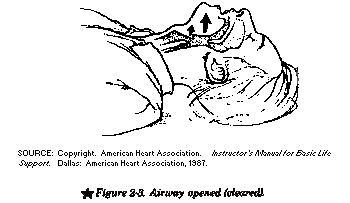
|
a. Step ONE (081-831-1042). Call for help and then position the casualty.
Move (roll) the casualty onto his back (Figure 2-1C above).
|
CAUTION
Take care in moving a casualty with a suspected neck or back injury. Moving an
injured neck or back may permanently injure the spine.
NOTE (081-831-1042)
If foreign material or vomitus is visible in the mouth, it should be removed, but do
not spend an excessive amount of time doing so.
b. Step TWO (081-31-1042). Open the airway using the jaw-thrust or head-tilt/chin-lift
technique. |
NOTE
The head tilt/chin lift is an important procedure in opening the airway; however, use
extreme care because excess force in performing this maneuver may cause further
spinal injury. In a casualty with a suspected neck injury or severe head trauma, the
safest approach to opening the airway is the jaw-thrust technique because in most
cases it can be accomplished without extending the neck.1
(1)Perform the jaw thrust technique. The jaw thrust may be accomplished by the
rescuer grasping the angles of the casualty's lower jaw and lifting with both hands, one
on each side, displacing the jaw forward and up (Figure 2-4). The
rescuer's elbows should rest on the surface on which the casualty is lying. If the lips
close, the lower lip can be retracted with the thumb. If mouth-to-mouth breathing is
necessary, close the nostrils by placing your cheek tightly against them. The head should
be carefully supported without tilting it backwards or turning it from side to side. If
this is unsuccessful, the head should be tilted back very slightly.2 The jaw thrust is the safest first approach
to opening the airway of a casualty who has a suspected neck injury because in
most cases it can be accomplished without extending the neck.
|

(2) Perform the head tilt/chin lift technique (081-831-1042). Place one hand
on the casualty's forehead and apply firm, backward pressure with the palm to tilt the
head back. Place the fingertips of the other hand under the bony part of the lower jaw and
lift, bringing the chin forward. The thumb should not be used to lift the chin (Figure 2-5).
NOTE
The fingers should not press deeply into the soft tissue under the chin because the
airway may be obstructed.
|
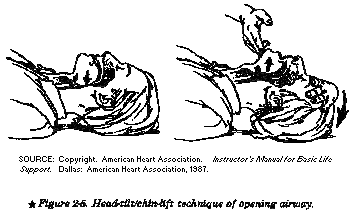
|
c. Step THREE. Check for breathing (while maintaining an airway). After
establishing an open airway, it is important to maintain that airway in
an open position. Often the act of just opening and maintaining the airway will allow the
casualty to breathe properly. Once the rescuer uses one of the techniques to open the
airway (jaw-thrust or head-tilt/chin-lift), he should maintain that head position to keep
the airway open. Failure to maintain the open airway will prevent the casualty from
receiving an adequate supply of oxygen. Therefore, while maintaining an open airway the
rescuer should check for breathing by observing the casualty's chest and performing the
following actions within 3 to 5 seconds:
(1) LOOK for the chest to rise and fall.
(2) LISTEN for air escaping during exhalation by placing your ear near
the casualty's mouth.
(3) FEEL for the flow of air on your cheek (see Figure
2-6).
(4) If the casualty does not resume breathing, give mouth-to-mouth resuscitation.
NOTE
If the casualty resumes breathing, monitor and maintain the open airway. If he
continues to breathe, he should be transported to a medical treatment facility.
|
a. If the casualty does not promptly resume adequate spontaneous breathing
after the airway is open, rescue breathing (artificial respiration) must be
started. Be calm! Think and act quickly! The sooner you begin rescue breathing, the more
likely you are to restore the casualty's breathing. If you are in doubt whether the
casualty is breathing, give artificial respiration, since it can do no harm to a person
who is breathing. If the casualty is breathing, you can feel and see his chest move. Also,
if the casualty is breathing, you can feel and hear air being expelled by putting your
hand or ear close to his mouth and nose.
|
b. There are several methods of administering rescue breathing. The
mouth-to-mouth method is preferred; however, it cannot be used in all situations. If the
casualty has a severe jaw fracture or mouth wound or his jaws are tightly closed by
spasms, use the mouth-to-nose method.
a. Step ONE. Establish unresponsiveness. Call for help. Turn or position the
casualty.
b. Step TWO. Open the airway.
c. Step THREE. Check for breathing by placing your ear
over the casualty's mouth and nose, and looking toward his chest:
(1) Look for rise and fall of the casualty's chest (Figure
2-6).
(2) Listen for sounds of breathing.
(3) Feel for breath on the side of your face. If the chest does not
rise and fall and no air is exhaled, then the casualty is breathless (not breathing).
(This evaluation procedure should take only 3 to 5 seconds.) Perform rescue
breathing if the casualty is not breathing.
|
NOTE
Although the rescuer may notice that the casualty is making respiratory efforts, the
airway may still be obstructed and opening the airway may be all that is needed. If the
casualty resumes breathing, the rescuer should continue to help maintain an open
airway.

|
In this method of rescue breathing, you inflate the casualty's lungs with air from your
lungs. This can be accomplished by blowing air into the person's mouth. The mouth-to-mouth
rescue breathing method is performed as follows:
a. Preliminary Steps.
(1) Step ONE (081-831-1048). If the casualty is not breathing, place your hand
on his forehead, and pinch his nostrils together with the thumb and index finger of this
same hand. Let this same hand exert pressure on his forehead to maintain the backward head-tilt
and maintain an open airway. With your other hand, keep your fingertips on the bony part
of the lower jaw near the chin and lift (Figure 2-7).
|
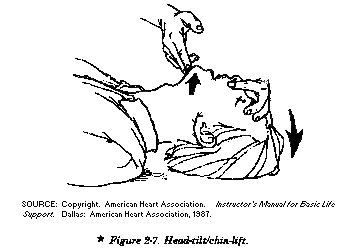
NOTE
If you suspect the casualty has a neck injury and you are using the jaw thrust
technique,
close the nostrils by placing your cheek tightly against them.3
(2) Step TWO (081-831-1042). Take a deep breath and place your mouth (in an
airtight seal) around the casualty's mouth (Figure 2-8). (If the
injured person is small, cover both his nose and mouth with your mouth, sealing your lips
against the skin of his face.)
|

(3) Step THREE (081-831-1042). Blow two full breaths into the casualty's mouth
(1 to 1 1/2 seconds per breath), taking a breath of fresh air each time before you blow.
Watch out of the corner of your eye for the casualty's chest to rise. If the chest rises,
sufficient air is getting into the casualty's lungs. Therefore, proceed as described in
step FOUR below. If the chest does not rise, do the following (a, b, and c
below) and then attempt to ventilate again.
(a) Take corrective action immediately by reestablishing the airway. Make sure
that air is not leaking from around your mouth or out of the casualty's pinched nose.
(b) Reattempt to ventilate.
(c) If chest still does not rise, take the necessary action to open an
obstructed airway (paragraph 2-14).
NOTE
If the initial attempt to ventilate the casualty is unsuccessful, reposition the
casualty's
head and repeat rescue breathing. Improper chin and head positioning is the most
common cause of difficulty with ventilation. If the casualty cannot be ventilated
after repositioning the head, proceed with foreign body airway obstruction maneuvers
(see Open an Obstructed Airway, paragraph 2-14).4
|
(4) Step FOUR (081-831-1042). After giving two breaths which cause the chest
to rise, attempt to locate a pulse on the casualty. Feel for a pulse on the side of the
casualty's neck closest to you by placing the first two fingers (index and middle fingers)
of your hand on the groove beside the casualty's Adam's apple (carotid pulse) (Figure 2-9). (Your thumb should not be used for pulse taking because
you may confuse your pulse beat with that of the casualty.) Maintain the airway by keeping
your other hand on the casualty's forehead. Allow 5 to 10 seconds to determine if there is
a pulse.
|
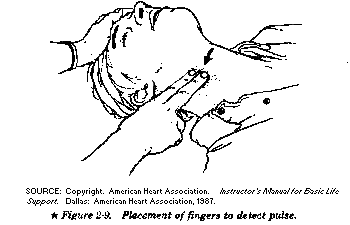
(a) If a pulse is found and the casualty is breathing --STOP; allow the
casualty to breathe on his own. If possible, keep him warm and comfortable.
(b) If a pulse is found and the casualty is not breathing, continue rescue
breathing.
*(c) If a pulse is not found, seek
medically trained personnel for help.
|
b. Rescue Breathing (mouth-to-mouth resuscitation) (081-831-1042). Rescue
breathing (mouth-to-mouth or mouth-to-nose resuscitation) is performed at the rate of
about one breath every 5 seconds (12 breaths per minute) with rechecks for pulse and
breathing after every 12 breaths. Rechecks can be accomplished in 3 to 5 seconds. See steps ONE through SEVEN (below) for specifics.
|
NOTE
Seek help (medical aid), if not done previously.
(1) Step ONE. If the casualty is not breathing, pinch his
nostrils together with the thumb and index finger of the hand on his forehead and let this
same hand exert pressure on the forehead to maintain the backward head-tilt (Figure 2-7).
(2) Step TWO. Take a deep breath and place your mouth (in an airtight seal)
around the casualty's mouth (Figure 2-8).
(3) Step THREE. Blow a quick breath into the casualty's mouth forcefully to
cause his chest to rise. If the casualty's chest rises, sufficient air is getting into his
lungs.
(4) Step FOUR. When the casualty's chest rises, remove your mouth from his
mouth and listen for the return of air from his lungs (exhalation).
(5) Step FIVE. Repeat this procedure (mouth-to-mouth resuscitation) at a rate
of one breath every 5 seconds to achieve 12 breaths per minute. Use the following count:
"one, one-thousand; two one-thousand; three, one-thousand; four, one-thousand; BREATH;
one one-thousand" and so forth. To achieve a rate of one breath every 5
seconds, the breath must be given on the fifth count.
*(6) Step SIX. Feel for a pulse after
every 12th breath. This check should take about 3 to 5 seconds. If a pulse beat is not
found, seek medically trained personnel for help.
*(7) Step SEVEN. Continue rescue
breathing until the casualty starts to breathe on his own, until you are relieved by
another person, or until you are too tired to continue. Monitor pulse and return of
spontaneous breathing after every few minutes of rescue breathing. If spontaneous
breathing returns, monitor the casualty closely. The casualty should then be transported
to a medical treatment facility. Maintain an open airway and be prepared to resume rescue
breathing if necessary.
Use this method if you cannot perform mouth-to-mouth rescue breathing because the
casualty has a severe jaw fracture or mouth wound or his jaws are tightly closed by
spasms. The mouth-to-nose method is performed in the same way as the mouth-to-mouth method
except that you blow into the nose while you hold the lips closed with one hand at the
chin. You then remove your mouth to allow the casualty to exhale passively. It may be
necessary to separate the casualty's lips to allow the air to escape during exhalation.
If a casualty's heart stops beating, you must immediately seek medically trained
personnel for help. SECONDS COUNT! Stoppage of the heart is soon followed
by cessation of respiration unless it has occurred first. Be calm! Think and act! When a
casualty's heart has stopped, there is no pulse at all; the person is unconscious and
limp, and the pupils of his eyes are open wide. When evaluating a casualty or when
performing the preliminary steps of rescue breathing, feel for a pulse. If you DO NOT
detect a pulse, immediately seek medically trained personnel.
*Paragraphs 2-9, 2-10, and
2-11 have been deleted. No text is provided.
In order for oxygen from the air to flow to and from the lungs, the upper airway must
be unobstructed.
a. Upper airway obstructions often occur because--
(1) The casualty's tongue falls back into his throat while he is unconscious as a
result of injury, cardiopulmonary arrest, and so forth. (The tongue falls back and
obstructs, it is not swallowed.)
(2) Foreign bodies become lodged in the throat. These obstructions usually occur while
eating (meat most commonly causes obstructions). Choking on food is associated with--
(3) The contents of the stomach are regurgitated and may block the airway.
(4) Blood clots may form as a result of head and facial injuries.
b. Upper airway obstructions may be prevented by taking the following
precautions:
(1) Cut food into small pieces and take care to chew slowly and thoroughly.
(2) Avoid laughing and talking when chewing and swallowing.
(3) Restrict alcohol while eating meals.
(4) Keep food and foreign objects from children while they walk, run, or play.
(5) Consider the correct positioning maintenance of the open airway for the injured or
unconscious casualty.
c. Upper airway obstruction may cause either partial or complete
airway blockage.
* (1) Partial airway
obstruction. The casualty may still have an air exchange. A good air exchange
means that the casualty can cough forcefully, though he may be wheezing between coughs.
You, the rescuer, should not interfere, and should encourage the casualty to cough up the
object on his own. A poor air exchange may be indicated by weak coughing with a
high pitched noise between coughs. Additionally, the casualty may show signs of shock (for
example, paleness of the skin bluish tint around the lips or fingernail beds)
indicating a need for oxygen. You should assist the casualty and treat him as though he
had a complete obstruction.
(2) Complete airway obstruction. A complete obstruction (no air exchange) is
indicated if the casualty cannot speak, breathe, or cough at all. He may be clutching his
neck and moving erratically. In an unconscious casualty a complete obstruction is also
indicated if after opening his airway you cannot ventilate him.
Clearing a conscious casualty's airway obstruction can be performed with the casualty
either standing or sitting, and by following a relatively simple procedure.
WARNING
Once an obstructed airway occurs, the brain will develop an oxygen deficiency resulting
in unconsciousness. Death will follow rapidly if prompt action is not taken.
|
a. Step ONE. Ask the casualty if he can speak or if he is choking. Check for
the universal choking sign (Figure 2-18).
|
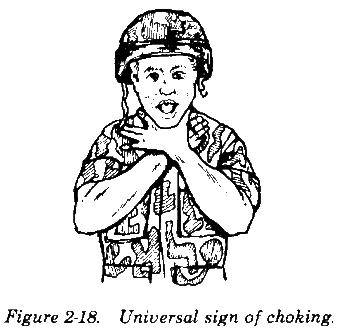
|
b. Step TWO. If the casualty can speak, encourage him to attempt to cough;
the casualty still has a good air exchange. If he is able to speak or cough
effectively, DO NOT interfere with his attempts to expel the obstruction.
c. Step
THREE. Listen for high pitched sounds when the casualty breathes or coughs (poor air
exchange). If there is poor air exchange or no breathing, CALL for HELP
and immediately deliver manual thrusts (either an abdominal or chest thrust).
|
NOTE
The manual thrust with the hands centered between the waist and the rib cage is called
an abdominal thrust (or Heimlich maneuver). The chest thrust (the hands are centered in
the middle of the breastbone) is used only for an individual in the advanced stages of
pregnancy, in the markedly obese casualty, or if there is a significant abdominal wound.
-
Apply ABDOMINAL THRUSTS using the procedures below:
o Stand behind
the casualty and wrap your arms around his waist.
o Make a fist with one hand and grasp it with the other. The thumb side of your fist
should be against the casualty's abdomen, in the midline and slightly above the casualty's
navel, but well below the tip of the breastbone (Figure 2-19).
|
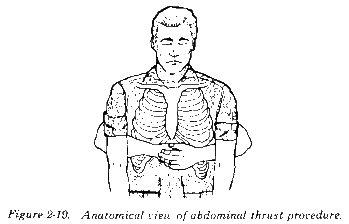

|
*NOTE
Continue performing abdominal thrusts until the obstruction is expelled or the casualty
becomes unconscious.
o If the casualty becomes unconscious, call for help as you proceed with steps to open
the airway and perform rescue breathing. See task
081-831-1042, Perform Mouth-to-Mouth Resuscitation.)
-
Applying CHEST THRUSTS. An alternate technique to the abdominal thrust
is the chest thrust. This technique is useful when the casualty has an abdominal wound,
when the casualty is pregnant, or when the casualty is so large that you cannot wrap your
arms around the abdomen. To apply chest thrusts with casualty sitting or standing:
o
Stand behind the casualty and wrap your arms around his chest with your arms under his
armpits.
o Make a fist with one hand and place the thumb side of the fist in the middle of the
breastbone (take care to avoid the tip of the breastbone and the margins of the ribs).
o Grasp the fist with the other hand and exert thrusts (Figure 2-21).
|
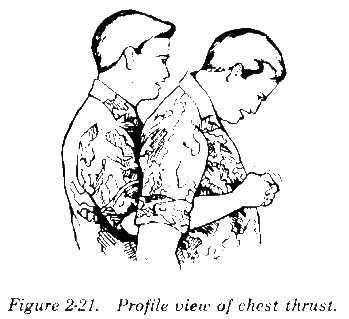
o Each thrust should be delivered slowly, distinctly, and with the intent of relieving
the obstruction.
o Perform chest thrusts until the obstruction is expelled or the casualty becomes
unconscious.
o If the casualty becomes unconscious, call for help as you proceed with steps to open
the airway and perform rescue breathing. (See task
081-831-1042, Perform Mouth-to-Mouth Resuscitation.)
|
2-14. Open an Obstructed Airway--Casualty Lying or Unconscious
(081-831-1042)
|
The following procedures are used to expel an airway obstruction in a casualty who is
lying down, who becomes unconscious, or is found unconscious (the cause unknown):
-
If a conscious casualty who is choking becomes unconscious, call for help, open the
airway, perform a finger sweep, and attempt rescue breathing (paragraphs 2-2 through 2-4). If you still cannot
administer rescue breathing due to an airway blockage, then remove the airway obstruction
using the procedures in steps a through e below.
-
If a casualty is unconscious when you find him (the cause unknown), assess or evaluate
the situation, call for help, position the casualty on his back, open the airway,
establish breathlessness, and attempt to perform rescue breathing (paragraphs 2-2 through 2-8).
|
a. Open the airway and attempt rescue breathing. (See task 081-831-1042, Perform Mouth-to-Mouth Resuscitation.)
b. If still unable to ventilate the casualty, perform 6 to 10 manual
(abdominal or chest) thrusts. (Note that the abdominal thrusts are used when casualty does
not have abdominal wounds; is not pregnant or extremely overweight.) To perform the
abdominal thrusts:
|

(2) Place the heel of one hand against the casualty's abdomen (in the midline slightly
above the navel but well below the tip of the breastbone). Place your other hand on top of
the first one. Point your fingers toward the casualty's head.
(3) Press into the casualty's abdomen with a quick, forward and upward thrust. You can
use your body weight to perform the maneuver. Deliver each thrust slowly and distinctly.
(4) Repeat the sequence of abdominal thrusts, finger sweep, and rescue breathing
(attempt to ventilate) as long as necessary to remove the object from the obstructed
airway. See paragraph d below.
(5) If the casualty's chest rises, proceed to feeling for pulse.
c. Apply chest thrusts. (Note that the chest thrust technique is an alternate
method that is used when the casualty has an abdominal wound, when the casualty is so
large that you cannot wrap your arms around the abdomen, or when the casualty is
pregnant.) To perform the chest thrusts:
(1) Place the unconscious casualty on his back, face up, and open his mouth. Kneel
close to the side of the casualty's body.
-
Locate the lower edge of the casualty's ribs with your fingers. Run the fingers up along
the rib cage to the notch (Figure 2-23A).
-
Place the middle finger on the notch and the index finger next to the middle finger on
the lower edge of the breastbone. Place the heel of the other hand on the lower half of
the breastbone next to the two fingers (Figure 2-23B).
-
Remove the fingers from the notch and place that hand on top of the positioned hand on
the breastbone, extending or interlocking the fingers (Figure 2-23C).
-
Straighten and lock your elbows with your shoulders directly above your hands without
bending the elbows rocking, or allowing the shoulders to sag. Apply enough pressure to
depress the breastbone 1 1/2 to 2 inches, then release the pressure completely (Figure 2-23D). Do this 6 to 10 times. Each thrust should be delivered
slowly and distinctly. See Figure 2-24 for another view of the
breastbone being depressed.
|
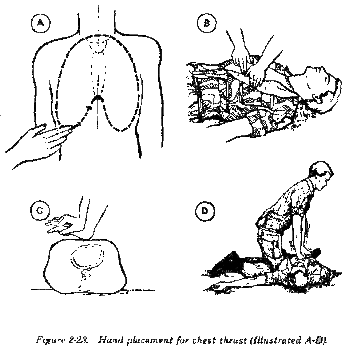
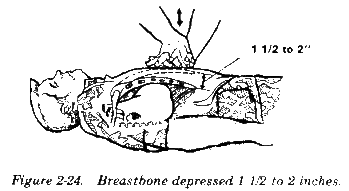
(2) Repeat the sequence of chest thrust, finger sweep, and rescue breathing as long as
necessary to clear the object from the obstructed airway. See paragraph
d below.
(3) If the casualty's chest rises, proceed to feeling for his pulse.
d. Finger Sweep. If you still cannot administer rescue
breathing due to an airway obstruction, then remove the airway obstruction using the
procedures in steps (1) and (2) below.
(1) Place the casualty on his back, face up, turn the unconscious casualty as a unit,
and call out for help.
(2) Perform finger sweep, keep casualty face up, use tongue-jaw lift to open mouth.
-
Open the casualty's mouth by grasping both his tongue and lower jaw between your thumb
and fingers and lifting (tongue-jaw lift) (Figure 2-25). If you are
unable to open his mouth, cross your fingers and thumb (crossed-finger method) and push
his teeth apart (Figure 2-26) by pressing your thumb against his
upper teeth and pressing your finger against his lower teeth.
|
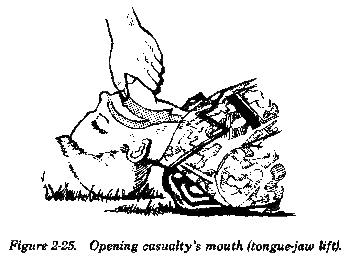


Section II. STOP THE BLEEDING AND PROTECT THE WOUND
|
In evaluating the casualty for location, type, and size of the wound or injury, cut or
tear his clothing and carefully expose the entire area of the wound. This procedure is
necessary to avoid further contamination. Clothing stuck to the wound should be left in
place to avoid further injury. DO NOT touch the wound; keep it as clean as possible.
WARNING (081-831-1016)
DO NOT REMOVE protective clothing in a chemical environment. Apply dressings
over the protective clothing.
|
Before applying the dressing, carefully examine the casualty to determine if there is
more than one wound. A missile may have entered at one point and exited at another point.
The EXIT wound is usually LARGER than the entrance wound.
WARNING
Casualty should be continually monitored for development of conditions which may
require the performance of necessary basic lifesaving measures, such as clearing the
airway and mouth-to-mouth resuscitation. All open (or penetrating) wounds should be
checked for a point of entry and exit and treated accordingly.
WARNING
If the missile lodges in the body (fails to exit), DO NOT attempt to remove it or probe
the wound. Apply a dressing. If there is an object extending from (impaled in) the
wound, DO NOT remove the object. Apply a dressing around the object and use
additional improvised bulky materials/dressings (use the cleanest material available) to
build up the area around the object. Apply a supporting bandage over the bulky
materials to hold them in place.
a. Use the casualty's field dressing; remove it from the wrapper and grasp the
tails of the dressing with both hands (Figure 2-28).
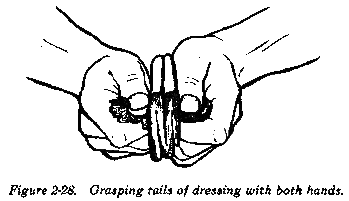
WARNING
DO NOT touch the white (sterile) side of the dressing, and DO NOT allow the white
(sterile) side of the dressing to come in contact with any surface other than the wound.
|
b. Hold the dressing directly over the wound with the white side down. Pull
the dressing open (Figure 2-29) and place it directly over the
wound (Figure 2-30). |
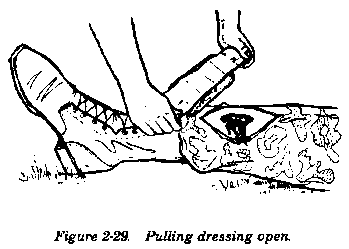

c. Hold the dressing in place with one hand. Use the other hand to wrap one of
the tails around the injured part, covering about one-half of the dressing (Figure 2-31). Leave enough of the tail for a knot. If the casualty is
able, he may assist by holding the dressing in place.
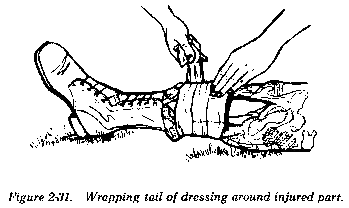
|
d. Wrap the other tail in the opposite direction until the remainder of the
dressing is covered. The tails should seal the sides of the dressing to keep foreign
material from getting under it.
e. Tie the tails into a nonslip knot over the
outer edge of the dressing (Figure 2-32). DO NOT TIE THE
KNOT OVER THE WOUND. In order to allow blood to flow to the rest of an injured
limb, tie the dressing firmly enough to prevent it from slipping but without causing a
tourniquet-like effect; that is, the skin beyond the injury becomes cool blue, or numb. |

2-18. Manual Pressure
(081-831-1016)
|
a. If bleeding continues after applying the sterile field dressing, direct
manual pressure may be used to help control bleeding. Apply such pressure by placing a
hand on the dressing and exerting firm pressure for 5 to 10 minutes (Figure
2-33). The casualty may be asked to do this himself if he is conscious and can follow
instructions. |
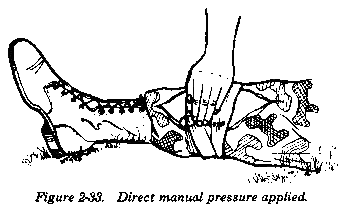
|
b. Elevate an injured limb slightly above the level of the heart to reduce
the bleeding (Figure 2-34). |
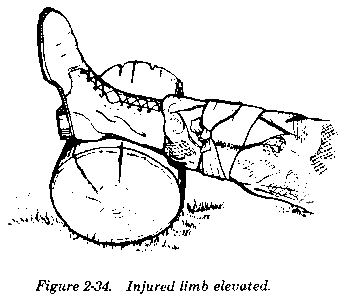
WARNING
DO NOT elevate a suspected fractured limb unless it has been properly splinted. (To
splint a fracture before elevating, see task 081-831-1034,
Splint a Suspected
Fracture.)
c. If the bleeding stops, check and treat for shock. If the bleeding
continues, apply a pressure dressing. |
2-19. Pressure Dressing (081-831-1016)
Pressure dressings aid in blood clotting and compress the open blood vessel. If
bleeding continues after the application of a field dressing, manual pressure, and
elevation, then a pressure dressing must be applied as follows:
a. Place a wad of padding on top of the field dressing, directly over the
wound (Figure 2-35). Keep injured extremity elevated.
|

NOTE
Improvised bandages may be made from strips of cloth. These strips may be made from
T-shirts, socks, or other garments.
|
b. Place an improvised dressing (or cravat, if available) over the wad of
padding (Figure 2-36). Wrap the ends tightly around the injured
limb, covering the previously placed field dressing (Figure 2-37).
|

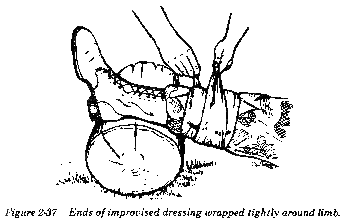
|
c. Tie the ends together in a nonslip knot directly over the wound site (Figure 2-38). DO NOT tie so tightly that it has a tourniquet-like
effect. If bleeding continues and all other measures have failed, or if the limb is
severed, then apply a tourniquet. Use the tourniquet as a LAST RESORT.
When the bleeding stops, check and treat for shock. |
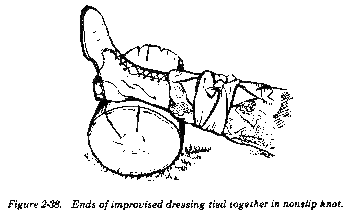
NOTE
Wounded extremities should be checked periodically for adequate circulation. The
dressing must be loosened if the extremity becomes cool, blue or numb.
*NOTE
If bleeding continues and all other measures have failed (dressing and covering wound,
applying direct manual pressure, elevating limb above heart level, and applying pressure
dressing maintaining limb elevation), then apply digital pressure. See Appendix E for appropriate pressure points.
2-20. Tourniquet (081-831-1017)
A tourniquet is a constricting band placed around an arm or leg to control bleeding. A
soldier whose arm or leg has been completely amputated may not be bleeding when first
discovered, but a tourniquet should be applied anyway. This absence of bleeding is due to
the body's normal defenses (contraction of blood vessels) as a result of the amputation,
but after a period of time bleeding will start as the blood vessels relax. Bleeding from a
major artery of the thigh, lower leg, or arm and bleeding from multiple arteries (which
occurs in a traumatic amputation) may prove to be beyond control by manual pressure. If
the pressure dressing under firm hand pressure becomes soaked with blood and the wound
continues to bleed, apply a tourniquet. |
WARNING
Casualty should be continually monitored for development of conditions which may
require the performance of necessary basic life-saving measures, such as: clearing the
airway, performing mouth-to-mouth resuscitation, preventing shock, and/or bleeding
control. All open (or penetrating) wounds should be checked for a point of entry or exit
and treated accordingly.
|
*The tourniquet should not be used unless
a pressure dressing has failed to stop the bleeding or an arm or leg has been cut off.
On occasion, tourniquets have injured blood vessels and nerves. If left in place too long,
a tourniquet can cause loss of an arm or leg. Once applied, it must stay in place, and the
casualty must be taken to the nearest medical treatment facility as soon as possible. DO
NOT loosen or release a tourniquet after it has been applied and the bleeding has stopped.
a. Improvising a Tourniquet (081-831-1017). In the absence of a specially
designed tourniquet, a tourniquet may be made from a strong, pliable material, such as
gauze or muslin bandages, clothing, or kerchiefs. An improvised tourniquet is used with a
rigid stick-like object. To minimize skin damage, ensure that the improvised tourniquet is
at least 2 inches wide. |
WARNING
The tourniquet must be easily identified or easily seen.
WARNING
DO NOT use wire or shoestring for a tourniquet band.
WARNING
|
b. Placing the Improvised Tourniquet (081-831-1017).
(1) Place the tourniquet around the limb, between the wound and the body trunk (or
between the wound and the heart). Place the tourniquet 2 to 4 inches from the edge of the
wound site (Figure 2-39). Never place it directly over a wound or
fracture or directly on a joint (wrist, elbow, or knee). For wounds just below a joint,
place the tourniquet just above and as close to the joint as possible.
|
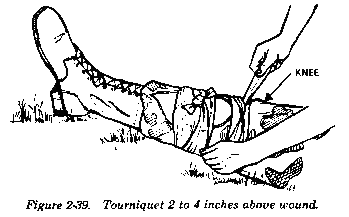
(2) The tourniquet should have padding underneath. If possible, place the tourniquet
over the smoothed sleeve or trouser leg to prevent the skin from being pinched or twisted.
If the tourniquet is long enough, wrap it around the limb several times, keeping the
material as flat as possible. Damaging the skin may deprive the surgeon of skin required
to cover an amputation. Protection of the skin also reduces pain.
c. Applying the Tourniquet (081-831-1017).
(1) Tie a half-knot. (A half-knot is the same as the first part of tying a shoe lace.)
(2) Place a stick (or similar rigid object) on top of the half-knot (Figure
2-40).
|
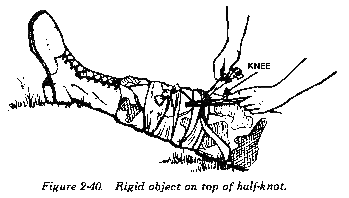

(4) Twist the stick (Figure 2-42) until the tourniquet is tight
around the limb and/or the bright red bleeding has stopped. In the case of amputation,
dark oozing blood may continue for a short time. This is the blood trapped in the area
between the wound and tourniquet.
|
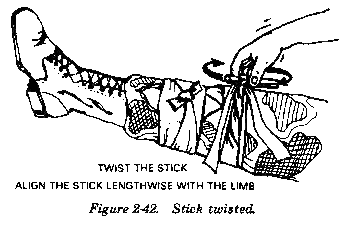
(5) Fasten the tourniquet to the limb by looping the free ends of the tourniquet over
the ends of the stick. Then bring the ends around the limb to prevent the stick from
loosening. Tie them together under the limb (Figure 2-43A and B).
|

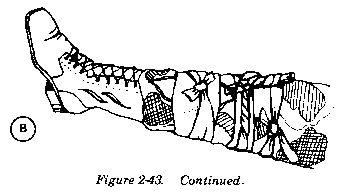
NOTE (081-831-1017)
Other methods of securing the stick may be used as long as the stick does not unwind
and no further injury results.
NOTE
If possible, save and transport any severed (amputated) limbs or body parts with (but
out of sight of) the casualty.
(6) DO NOT cover the tourniquet--you should leave it in full view. If the limb is
missing (total amputation), apply a dressing to the stump.
(7) Mark the casualty's forehead, if possible, with a "T" to indicate a
tourniquet has been applied. If necessary, use the casualty's blood to make this mark.
(8) Check and treat for shock.
(9) Seek medical aid.
CAUTION (081-831-1017)
DO NOT LOOSEN OR RELEASE THE TOURNIQUET ONCE IT HAS BEEN APPLIED BECAUSE IT COULD
ENHANCE THE PROBABILITY OF SHOCK.
|
Section III. CHECK AND TREAT FOR SHOCK
2-21. Causes and Effects
a. Shock may be caused by severe or minor trauma to the body. It usually is
the result of--
-
Significant loss of blood.
-
Heart failure.
-
Dehydration.
-
Severe and painful blows to the body.
-
Severe burns of the body.
-
Severe wound infections.
-
Severe allergic reactions to drugs, foods, insect stings, and snakebites.
b. Shock stuns and weakens the body. When the normal blood flow in the body is
upset, death can result. Early identification and proper treatment may save the casualty's
life.
c. See FM 8-230 for further information and details on specific types of shock
and treatment.
2-22. Signs/Symptoms
(081-831-1000)
Examine the casualty to see if he has any of the following signs/symptoms:
-
Sweaty but cool skin (clammy skin).
-
Paleness of skin.
-
Restlessness, nervousness.
-
Thirst.
-
Loss of blood (bleeding).
-
Confusion (or loss of awareness).
-
Faster-than-normal breathing rate.
-
Blotchy or bluish skin (especially around the mouth and lips).
-
Nausea and/or vomiting.
2-23. Treatment/Prevention
(081-831-1005)
In the field, the procedures to treat shock are identical to procedures that
would be performed to prevent shock. When treating a casualty, assume that shock
is present or will occur shortly. By waiting until actual signs/symptoms of shock are
noticeable, the rescuer may jeopardize the casualty's life.
|
a. Position the Casualty. (DO NOT move the casualty or his limbs if suspected
fractures have not been splinted. See Chapter 4 for details.)
(1) Move the casualty to cover, if cover is available and the situation permits.
(2) Lay the casualty on his back.
NOTE
A casualty in shock after suffering a heart attack, chest wound, or breathing
difficulty,
may breathe easier in a sitting position. If this is the case, allow him to sit upright,
but
monitor carefully in case his condition worsens.
(3) Elevate the casualty's feet higher than the level of his heart. Use a stable object
(a box, field pack, or rolled up clothing) so that his feet will not slip off (Figure 2-44).
WARNING
DO NOT elevate legs if the casualty has an unsplinted broken leg, head injury, or
abdominal injury. (See task 081-831-1034, Splint a
Suspected Fracture, and task 081-831-1025, Apply
a Dressing to an Open Abdominal Wound.)
|
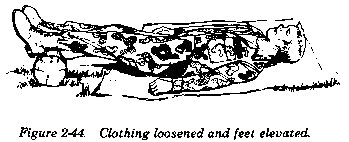
WARNING (081-831-1005)
Check casualty for leg fracture(s) and splint, if necessary, before elevating his feet.
For a casualty with an abdominal wound, place knees in an upright (flexed) position.
(4) Loosen clothing at the neck, waist, or wherever it may be binding.
|
CAUTION (081-831-1005)
(5) Prevent chilling or overheating. The key is to maintain body temperature. In cold
weather, place a blanket or other like item over him to keep him warm and under him to
prevent chilling (Figure 2-45). However, if a tourniquet has been
applied, leave it exposed (if possible). In hot weather, place the casualty in the shade
and avoid excessive covering.
|
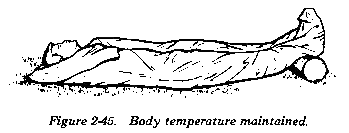
(6) Calm the casualty. Throughout the entire procedure of treating and caring for a
casualty, the rescuer should reassure the casualty and keep him calm. This can be done by
being authoritative (taking charge) and by showing self-confidence. Assure the casualty
that you are there to help him.
|
|
b. Food and/or Drink. During the treatment/prevention of shock, DO NOT give
the casualty any food or drink. If you must leave the casualty or if he is unconscious,
turn his head to the side to prevent him from choking should he vomit (Figure
2-46). |
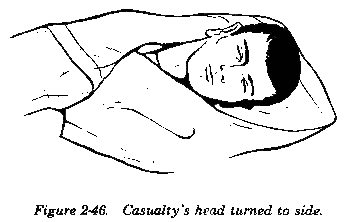
c. Evaluate Casualty. If necessary, continue with the casualty's evaluation.
1. American Heart Association (AHA).
Instructor's Manual for Basic Life Support (Dallas: AHA, 1987), p. 37.
2. Ibid.
3. Ibid.
4. Ibid., p. 38
|









































